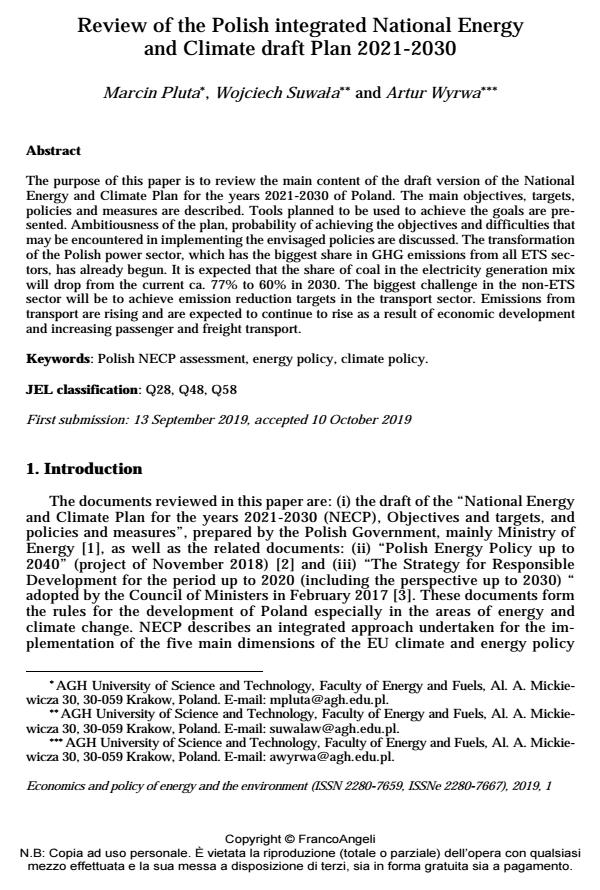Review of the Polish integrated National Energy and Climate draft Plan 2021-2030
Titolo Rivista ECONOMICS AND POLICY OF ENERGY AND THE ENVIRONMENT
Autori/Curatori Marcin Pluta, Wojciech Suwala, Artur Wyrwa
Anno di pubblicazione 2019 Fascicolo 2019/1
Lingua Inglese Numero pagine 12 P. 149-160 Dimensione file 170 KB
DOI 10.3280/EFE2019-001009
Il DOI è il codice a barre della proprietà intellettuale: per saperne di più
clicca qui
Qui sotto puoi vedere in anteprima la prima pagina di questo articolo.
Se questo articolo ti interessa, lo puoi acquistare (e scaricare in formato pdf) seguendo le facili indicazioni per acquistare il download credit. Acquista Download Credits per scaricare questo Articolo in formato PDF

FrancoAngeli è membro della Publishers International Linking Association, Inc (PILA)associazione indipendente e non profit per facilitare (attraverso i servizi tecnologici implementati da CrossRef.org) l’accesso degli studiosi ai contenuti digitali nelle pubblicazioni professionali e scientifiche
The purpose of this paper is to review the main content of the draft version of the National Energy and Climate Plan for the years 2021-2030 of Poland. The main objectives, targets, policies and measures are described. Tools planned to be used to achieve the goals are presented. Ambitiousness of the plan, probability of achieving the objectives and difficulties that may be encountered in implementing the envisaged policies are discussed. The transformation of the Polish power sector, which has the biggest share in GHG emissions from all ETS sectors, has already begun. It is expected that the share of coal in the electricity generation mix will drop from the current ca. 77% to 60% in 2030. The biggest challenge in the non-ETS sector will be to achieve emission reduction targets in the transport sector. Emissions from transport are rising and are expected to continue to rise as a result of economic development and increasing passenger and freight transport.
Parole chiave:Polish NECP assessment, energy policy, climate policy.
Jel codes:Q28, Q48, Q58
- Emission accounting and drivers in 2004 EU accession countries Lin Xiao, Yuru Guan, Yaqin Guo, Rui Xue, Jiashuo Li, Yuli Shan, in Applied Energy 118964/2022 pp.118964
DOI: 10.1016/j.apenergy.2022.118964 - Review of Energy and Climate Plans of Baltic States: The Contribution of Renewables for Energy Production in Households Dalia Streimikiene, Grigorios L. Kyriakopoulos, Gintare Stankuniene, in Energies /2022 pp.7728
DOI: 10.3390/en15207728 - Impact of Key Drivers on Energy Intensity and GHG Emissions in Manufacturing in the Baltic States Vaclovas Miskinis, Arvydas Galinis, Viktorija Bobinaite, Inga Konstantinaviciute, Eimantas Neniskis, in Sustainability /2023 pp.3330
DOI: 10.3390/su15043330 - Geological CO2 storage assessment in emerging CCS regions: Review of sequestration potential, policy development, and socio-economic factors in Poland Mohammad Nooraiepour, Karol M. Dąbrowski, Mohammad Masoudi, Szymon Kuczyński, Zezhang Song, Ane Elisabet Lothe, Helge Hellevang, in International Journal of Greenhouse Gas Control 104524/2025 pp.104524
DOI: 10.1016/j.ijggc.2025.104524
Marcin Pluta, Wojciech Suwala, Artur Wyrwa, Review of the Polish integrated National Energy and Climate draft Plan 2021-2030 in "ECONOMICS AND POLICY OF ENERGY AND THE ENVIRONMENT" 1/2019, pp 149-160, DOI: 10.3280/EFE2019-001009